Roundtable Discussion: Voorhees Discusses Managing Treatment in Multiple Myeloma
During a Targeted Oncology case-based roundtable event, Peter Voorhees, MD, discussed therapy options and transplant eligibility for patients with multiple myeloma.
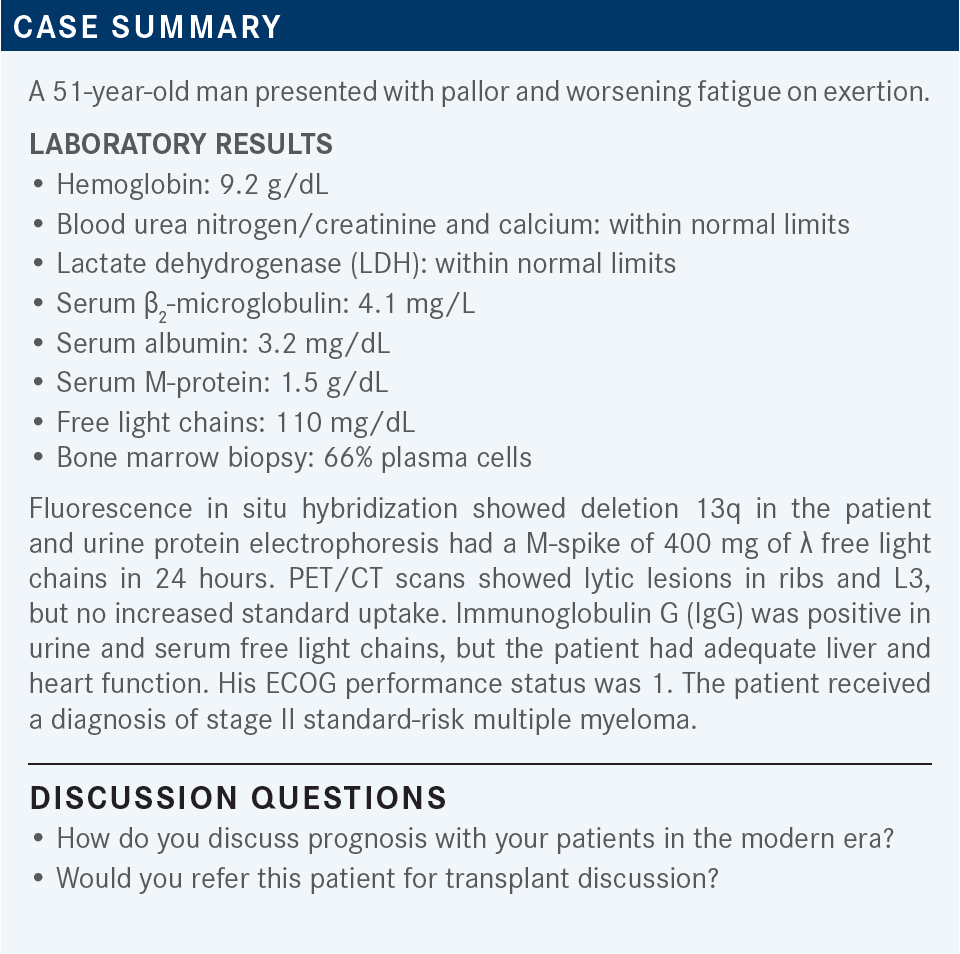
Peter Voorhees, MD
Hematologist and Medical Oncologist
Atrium Health Levine Cancer Institute
Charlotte, NC
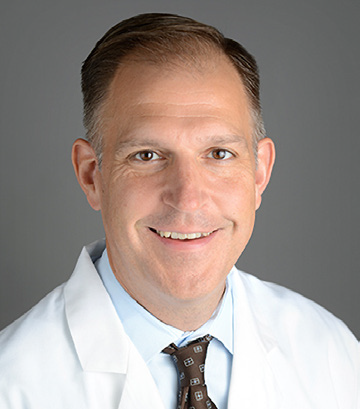

BENDANDI: I have quite a few of these patients. I would tell them that the situation is not as bad as it used to be 25 years ago when I started out. You would not most likely be dead within 5 years, as would have happened 25 years ago, but right now, prognostically, he’s unlikely to have a normal life expectancy. Therefore, we should throw, in due order, the kitchen sink at him, including stem cell transplant, even though I am not a great fan of transplant in general for multiple myeloma.
VOORHEES: Can anyone take a crack at what an expected overall survival [OS] might be for a 51-year-old patient with R-ISS [Revised International Staging System] stage II disease?
MADADI: In general, probably I would discuss with them that it’s [approximately] 8 to 10 years on average, but with newer therapies coming it might be better.
VOORHEES: Yes, I think that’s incredibly accurate, based on the literature that’s been published thus far. You’re right, too, that it’s a moving target with the immunotherapies, particularly these T-cell redirecting therapies that are in development. It’s in constant evolution. So, [patients with] ISS stage I disease have an OS well over 10 years, when they’re transplant eligible and ISS II is approaching that 10-year mark and beyond, as well.1 The [patients with] ISS stage III disease still don’t do as well as their stage I and II counterparts, for sure.
Now, this patient is 51 years old and, as Dr Bendandi suggested, [their doctor would] begrudgingly refer them for consideration of autologous stem cell transplant [ASCT]. I understand those reservations. Who would not refer this patient for a discussion of frontline ASCT and high-dose melphalan [Alkeran] therapy? If we were in the Northeast, we would have [clinicians] piping up and saying that they wouldn’t necessarily do it, but I’m sensing [for this group], this is the type of patient you would refer to someone who does ASCT.
NATHWANI: [We refer] most of our patients, and the transplant physicians always request us to send them early on….They’d rather see them earlier and have all the information available as early as possible, so we always send them [early].
BENDANDI: I completely agree with this because….I tell the patient, “Hey, I’m not a great fan of ASCT because of this and that. However, there are doctors who would be great fans of it. I think that you should hear from both sides…and then make your own decision.”
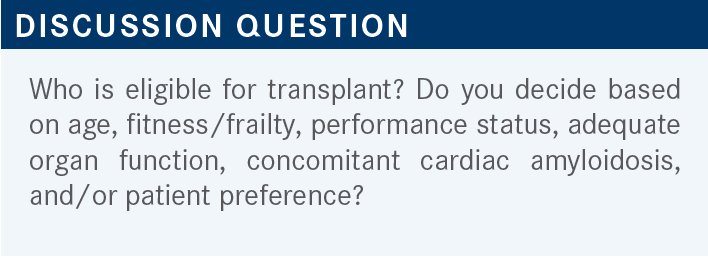
BENDANDI: I agree with the [factors mentioned here]. I have to say, however, that we have objective ways to measure fitness, performance status, and adequate organ function. Of course, patient preference is paramount—it is yes or no in the end. With respect to age, precisely because with or without transplant, the goal for a patient [such as] this should be to try to live 8 to 10 years, and the average age of survival for the White population, at least in the United States, is 79.5 years.2 I would argue strongly against transplant after age 70, even in a perfectly fit patient.
VOORHEES: Yes, [I concur].
BENDANDI: I think that with or without CAR [chimeric antigen receptor] T-cell therapy, bispecific drugs are coming to fruition, and these patients should live 8 to 10 years probably even without transplant, unless [their] cytogenetics change.
VOORHEES: Does anybody else have any thoughts about transplant eligibility?
NATHWANI: I don’t know if there’s an actual [age] cutoff, because [transplanters even] say up to 80 years if they’re doing well. We’ve seen a whole range there, so I don’t know if the age plays that much of an important role at this point. My experience is that seems to be a moving number.
BENDANDI: Precisely. The problem, in my opinion, is financial toxicity. You have a patient, he’s 77 or 74 years old, ECOG performance score of 1, decent heart, liver, kidney function and then you throw at him a $2 million procedure at [The University of Texas MD Anderson Cancer Center]. I think that’s not justified.
VOORHEES: I guess what I would say regarding age is that it is tightly linked to fitness, frailty, performance status, and adequate organ function. But at the same time, there are patients in their 70s who, for all intents and purposes, are just as healthy as a 55-year-old you may have seen the previous day and counseled about ASCT. There [are] retrospective data from the Center for International Blood and Marrow Transplant Research showing that treatment-related toxicity and mortality with ASCT in patients beyond the age of 70 [are] actually very low and very similar to younger patients. Now, [those are] retrospective data and there’s selection bias, but if patients are picked appropriately, you can feasibly do ASCTs for patients in their 70s. As you get to [age] 80 and beyond, then things get quite dicey. It’s a case-by-case decision-making process, and you must look at all factors of the disease, including whether they have standard-risk or high-risk disease and what their preferences are.

BENDANDI: Personally, if there [are] no high-risk cytogenetics, then no quadruplet. That’s the way I will use them.
[What do you think is the best approach (doublet, triplet, quadruplet) to primary therapy?]
VOORHEES: Biologically they do not have high-risk disease, so why introduce a fourth drug and expose them to [adverse effects]?
BENDANDI: I assume if we go for ASCT and a quadruplet does the job for the ASCT, then it’s very difficult to justify it. With the triplet, we know what to expect, and we know what to expect with ASCT.
VOORHEES: Who voted for VRd [bortezomib (Velcade), lenalidomide (Revlimid), dexamethasone] as induction therapy for this patient?
MCKAY: I still debate this a lot myself, too. I know that daratumumab [Darzalex] obviously has some sort of survival benefit if you get it at some point during your therapy. In the GRIFFIN trial [NCT02874742] the 3-year progression-free survival [PFS] difference was [approximately] 8%.3 So that’s what I struggle with. For 3 years of daratumumab you get an 8% PFS difference. I know I’d like to incorporate it somewhere, but I struggle with where to put it in at this point. I know there’s survival benefit, [from the results of] the CASTOR [NCT02136134] and POLLUX [NCT02076009] trials, so there’s benefit, it’s just a matter of where to plug it into.4,5
VOORHEES: Anyone else on the triplet side of things want to comment?
MADADI: I [have] started using it more and more. I agree that for high-risk patients, we need more data. But I think with the GRIFFIN trial the goal was to get as much disease control as possible prior to ASCT, especially in transplant-eligible patients.
VOORHEES: Any other comments from those who voted for the quadruplet?
PAUL: I voted for the quadruplet based on the GRIFFIN data. The GRIFFIN data do not necessarily support that this is only necessary for patients with high-risk cytogenetics. It has the survival advantage, or the trend toward the PFS advantage in all patients. It also had a deepening of response at all stages of treatment, so that’s before induction, after induction, after transplant, and with consolidation. The deeper response with the addition of a CD38 antibody is real, in my opinion. In the era we’re at with myeloma therapy, as many have said before, going for the deepest response that you can get, ideally, to a minimal residual disease [MRD]–negative remission makes a lot of sense to me, and that’s why I would use the quadruplet in patients regardless of their cytogenetic status.
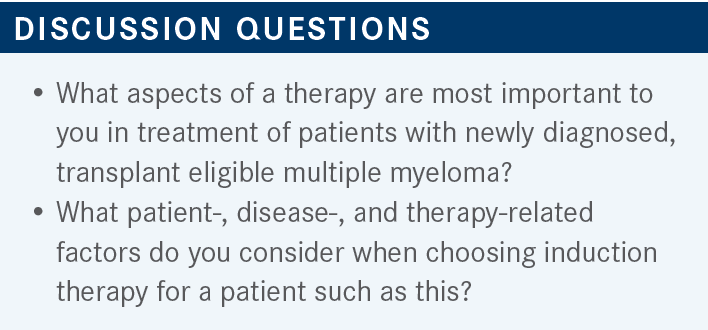
VOORHEES: I think it’s a discussion of the risks, the toxicities of a particular therapy vs the potential benefits as far as remission and durability of remission are concerned. Is the ability to achieve MRD-negativity, like Dr Paul just mentioned, of primary importance to you, or are you looking at something else?
BENDANDI: To me, what matters is OS. Now we have more medications and treatment options and there is some attrition among lines of treatment, but we have more therapeutic options than chances to use them in any given patient. My concern with the patient is I’ll try to keep you alive any way I can—before we knew that you would die in 5 years. But from the lenalidomide era, if you stay alive, something else is going to come up, in fact, we have a redundancy in isatuximab [Sarclisa]. I have probably 15 patients who ask me to go on treatment holidays, and probably double digit of them have stayed 2 or 3 years without the paraprotein moving a milligram. Everything is possible. Of course, this is a patient who is 51 years old, and I can’t guarantee a normal life duration. I understand being more aggressive, but I don’t know that achieving MRD in any given line of treatment will prolong his life.
PAUL: I agree that we do not have prospective data at this point to support that MRD negativity is consistent with an OS advantage. Retrospectively, there are some data that at least support that hypothesis. I would argue that, in my experience, an upfront MRD-negative remission is more valuable than an MRD-negative remission in subsequent lines of therapy, because I find that the duration of response still is higher in your earlier lines of therapy, even if you’re getting to an extraordinarily deep response. I’m a proponent of taking my best shot up front, when a patient ideally has the best performance status, has more treatment-naïve myeloma, has a healthier immune microenvironment to take advantage of. Again, that is why I typically would offer a quadruplet up front, but I can understand the argument to the contrary.
VOORHEES: The most updated National Comprehensive Cancer Network [NCCN] guidelines for treatment of transplant-eligible multiple myeloma patients list VRd induction regimen as category 1 and the preferred regimen. The other recommended regimens include KRd [carfilzomib (Kyprolis), lenalidomide [Revlimid], dexamethasone], daratumumab-VRd, and, perhaps surprisingly and I think that they need to delete this, ixazomib [Ninlaro], lenalidomide, dexamethasone, which is a category 2B.6 The only reason I say that is because there are data out there suggesting that the addition of ixazomib to lenalidomide and dexamethasone for [patients who are] newly diagnosed transplant ineligible did not have any beneficial impact on PFS.
We’ve already talked about disease biology, whether you have standard-risk vs high-risk disease, with some participants suggesting that they would lean away [from] quadruplet therapy for somebody who has standard-risk disease, whereas others suggesting that the quadruplet performs better than the triplet regardless of cytogenetic risk.
MCKAY: At this point, I don’t usually weigh their genetic risk in how I select it yet. I don’t know if there are a lot of data to suggest, at least from my understanding, which helps in that direction for me. Obviously, the renal function’s a big deal, a lot of times [patients] come in the hospital and they have bad kidney function, and we try to get them on cyclophosphamide and bridge into lenalidomide. My biggest branching point is always [whether] they’re transplant eligible or ineligible and sometimes convenience as well. [For instance, I take into consideration] how far away they are from our center.
VOORHEES: Does anybody else want to make a comment?
BENDANDI: What about λ light chain? I don’t know whether this is just me, but in my experience, anything else equal, λ light chain carries one of the worst prognoses.
VOORHEES: Yes, so I think when patients have λ light chain multiple myeloma, that does increase the risk of renal impairment at initial diagnosis. I think λ light chains in general tend to be more nephrotoxic than κ light chains, although they both can be, obviously. I think that there may be a gravitation toward a higher proportion of high-risk cytogenetic abnormalities in some of these free λ light chain patients. When accounting for the cytogenetic abnormalities, the fact that it’s λ light chain, in and of itself, does not carry as much weight. But I agree with you, those patients oftentimes are very difficult to treat because they have high-risk disease biology, whether it’s cytogenetic risk, high LDH, extramedullary disease, etc.
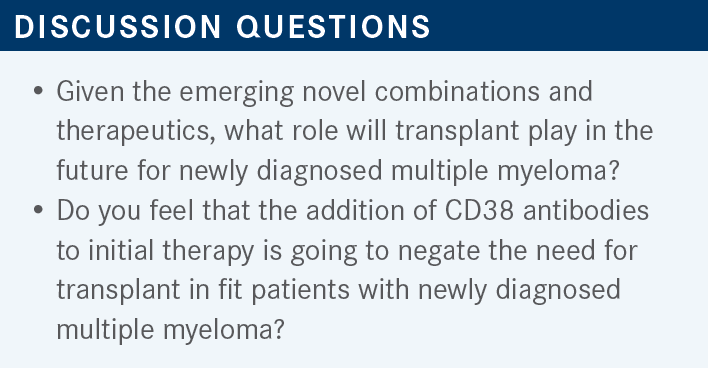
BENDANDI: I don’t know whether you remember follicular lymphoma 25 years ago. It was watch and wait until you can’t, and then use CVP [cyclophosphamide (Cytoxan), vincristine (Oncovin), prednisone], RFMD [(rituximab (Rituxan), fludarabine (Fludara), mitoxantrone (Novantrone), dexamethasone], or R-CHOP [rituximab, cyclophosphamide, doxorubicin, vincristine, prednisone], then good luck with the transplant. Transplant in follicular lymphoma does not exist anymore. What am I implying? Once OS stops being the primary end point of clinical trials that’s great news. We don’t use OS in follicular lymphoma now, [we haven’t] for 20 years. Why? Because by the time the trial is over, one is long retired. No principal investigator would ever see the end of the trial, so I think we are getting there. Not to mention bispecific drugs, CAR T-cell therapy, and belantamab [Blenrep], you name it. Thank goodness we are going in that direction, but it’s going to take some time.
VOORHEES: Are we at a point now where transplant is no longer necessary?
MCKAY: I think it still has a role, especially compared with a lot of these novel treatments. It’s still relatively cheap. Compared with a couple years of PFS benefit vs a new therapy, ASCT almost ends up being a [less expensive] option. It still has mortality benefit, and in higher volume centers it still has a low mortality. I still am a big believer in ASCT, and one sees a deepening response with it, too, so I think there are a lot of benefits for it.
BENDANDI: It also depends on the nature of the practice. If you have an infusion center, infusion’s important and oral treatment is less important. If you work in a Veterans Affairs hospital, you have only 3 centers nationwide that perform transplant. Of course, there are logistics that can throw a wrench into the process of referring and having the transplant performed, and so on, but it depends on things that are not strictly clinical.
VOORHEES: I think that all those points are very well taken. Are there any carfilzomib enthusiasts in the group? We’ve talked about bortezomib-based induction strategies for this group of patients. But carfilzomib, lenalidomide, and dexamethasone is one of the options listed in the NCCN guidelines.
PAUL: I will consider using that in patients with significant baseline neuropathy, just because I worry about the addition of bortezomib, even in a quadruplet setting. I’ve tried to get Dara-KRd [daratumumab-KRd] off label for a handful of these patients with some success, but [it often is a] failure. In general, if I have a patient with lots of neuropathy at baseline I’ll try to avoid a bortezomib-based induction regimen.
VOORHEES: Yes, I would agree with that, and that’s the most common space where I would use carfilzomib over bortezomib—in the frontline setting. Is there anybody who favors a carfilzomib-based platform for those patients who have high-risk cytogenetics at initial diagnosis?
MCKAY: I know there are some subgroup analyses that suggest for patients with 1q21 abnormalities, carfilzomib might mitigate that. I was getting [a few] referrals for patients who start on it because of that. I think it was an unplanned subgroup analysis of the trial, so I don’t know how much weight to put on it. I don’t know if there were any specific areas that I’d favor carfilzomib.
VOORHEES: Yes, we have a head-to-head comparison of RVd and KRd in the ENDURANCE trial [NCT01863550] in patients who were either ineligible for or who elected not to pursue frontline transplant. There was no difference in outcomes with regards to PFS or OS; however it was exclusively in standard-risk cytogenetic patients. The question remains unanswered. I will mention that when we included the patients with 1q21 gain into our high-risk definition in the GRIFFIN analysis, we saw a clear improvement in MRD negativity.
Based on the data that I’ve reviewed, I think no one would question an improvement in MRD negativity by adding daratumumab to the RVd backbone. I think that’s clear. I think that the PFS data look awfully good. I hope [the data] continue to mature well over time, but [they are] looking good. We have no OS difference, and it’s going to take many years to see if it ever materializes. It very well may not because of all the therapies available in subsequent lines of therapy. So for those of you who voted for the triplet, what would you need to see to change practice from either the GRIFFIN or the PERSEUS trial [NCT03710603]?
BENDANDI: I would be more tempted to use the quadruplet more and change my practice if it meant not having to use transplant. Or even adding daratumumab as a maintenance after the given number of VRd cycles that I’ve stipulated with the patient, assuming there is no progression, or resistance, or anything like that.
VOORHEES: You feel that if there was a study that showed that using a quadruplet up front obviated the need for a frontline transplant, that would be enough to sway you over to the quadruplet?
BENDANDI: Yes. Now, [are you using MRD assessment routinely in your practice?]
OLAJIDE: We don’t have access to that, except for being a send-out. So we’re not using it routinely. We do have patients who are seen at our main campus at Chapel Hill, [North Carolina], who do get that, but we don’t use it routinely.
VOORHEES: Who here is using MRD testing to guide therapy?
PAUL: I’ll use it at times if I have a patient who is [having a difficult time] with maintenance stage therapy as a possible breakpoint to consider taking them off maintenance if they’ve had a sustained MRD-negative remission for a period.
VOORHEES: Yes, I would agree.
REFERENCES
1. American Cancer Society. Survival rates for multiple myeloma. March 2, 2022. Accessed May 31, 2022. https://bit.ly/3N96tFp
2. Dong J, Garacci Z, Buradagunta CS, et al. Black patients with multiple myeloma have better survival than White patients when treated equally: a matched cohort study. Blood Cancer J. 2022;12(2):34. doi:10.1038/s41408-022-00633-5
3. Voorhees PM, Kaufman JL, Laubach J, et al. Daratumumab, lenalidomide, bortezomib, and dexamethasone for transplant-eligible newly diagnosed multiple myeloma: the GRIFFIN trial. Blood. 2020;136(8):936-945. doi:10.1182/blood.2020005288
4. Palumbo A, Chanan-Khan A, Weisel K, et al; CASTOR Investigators. Daratumumab, bortezomib, and dexamethasone for multiple myeloma. N Engl J Med. 2016;375(8):754-766. doi:10.1056/NEJMoa1606038
5. Bahlis NJ, Dimopoulos MA, White DJ, et al. Daratumumab plus lenalidomide and dexamethasone in relapsed/refractory multiple myeloma: extended follow-up of POLLUX, a randomized, open-label, phase 3 study. Leukemia. 2020(7):1875-1884. doi:10.1038/s41375-020-0711-6
6. NCCN. Clinical Practice Guidelines in Oncology. Multiple myeloma, version 5.2022. March 9, 2022. Accessed May 18, 2022. https://bit.ly/3fa9Yx5
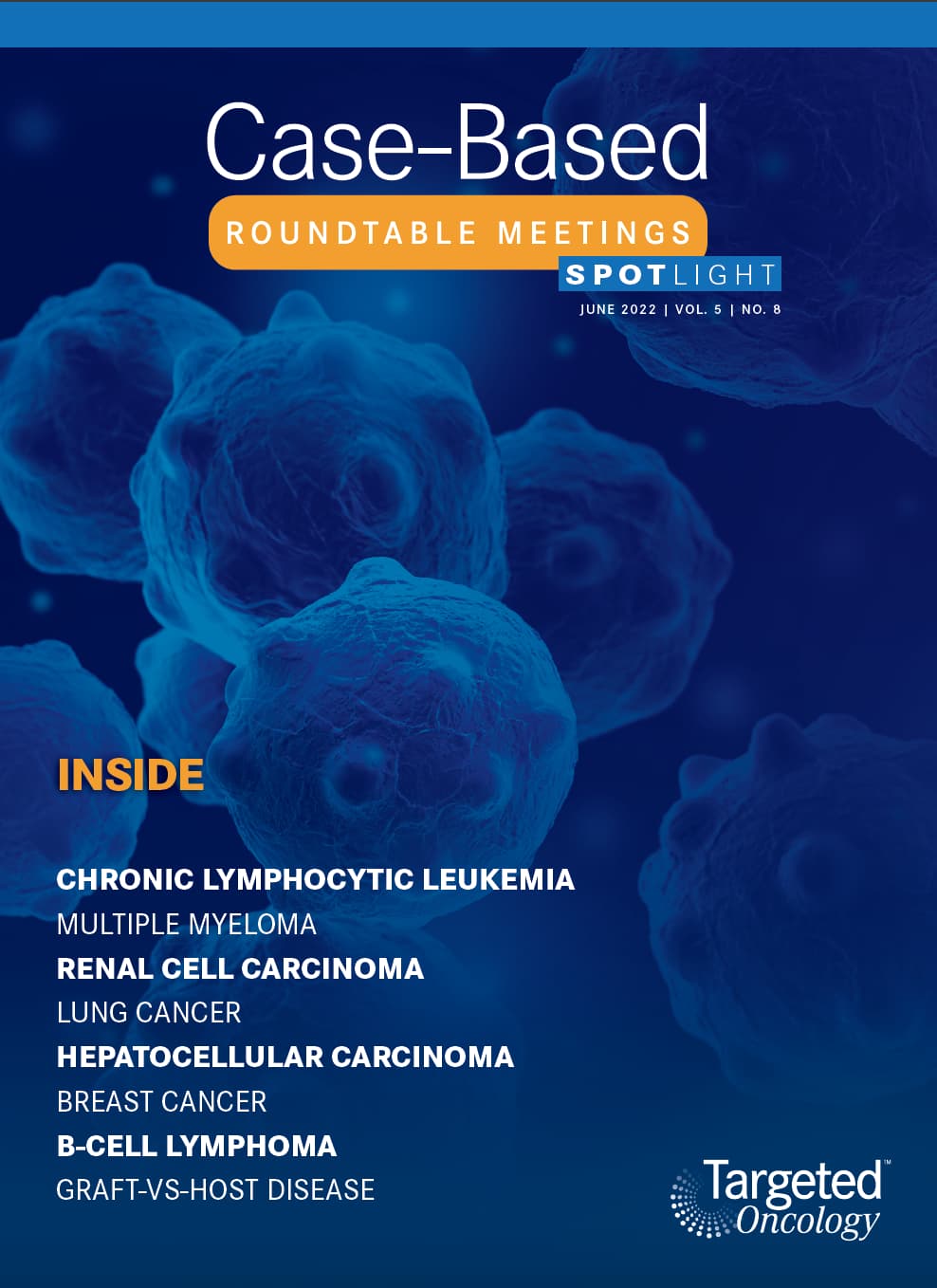
Survivorship Care Promotes Evidence-Based Approaches for Quality of Life and Beyond
March 21st 2025Frank J. Penedo, PhD, explains the challenges of survivorship care for patients with cancer and how he implements programs to support patients’ emotional, physical, and practical needs.
Read More